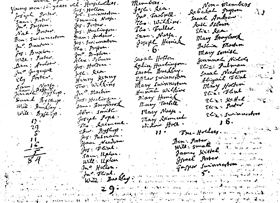The 1695 Parris Petitions
It is not possible to directly determine where most Salem Villagers stood on issues that divided the community. Historical documents, like the village's Book of Record, Samuel Parris's church records, and other material, provide important evidence as to where some of the village's leadership, political and religious, stood on various controversies. But they are less forthcoming about the general population of the village. For example, beginning October 1691, various village committees expressed their displeasure with Parris by refusing to collect his salary. But the records do not reveal which members of the general village population approved or opposed this action. And there was no referendum recording how villagers felt about the witch hunt of 1692.
However, there is an indirect way to determine the position of Salem Villagers regarding their minister and the witch hunt. Dissatisfaction with Parris continued to fester among some villagers long after the witch trials were over. In late April or early May 1695, Parris's enemies presented a petition to the elders of neighboring churches, hoping to pressure Parris to step down. Eighty-four villagers signed this Anti-Parris Petition. The signers identified themselves under six group labels: Sixteen males signed as "young men--16 years old"; twenty-nine men signed as "householders"; six men signed as church "members"; eleven women signed as church "members"; sixteen women signed as church "non-members"; and five males signed as "free-holders," an uncertain designation likely meaning that these men were members of a church other than Salem Village's.
Parris's supporters soon countered with a petition of their own. The resulting Pro-Parris Petition of May 1695, contained 105 names, identified in four groups. Twenty-four women signed as "householders"; twenty-nine men signed as "householders"; twenty-five men signed as "church-members"; and twenty-seven women signed as "church-members."
The two petitions are not direct measures of how Salem Villagers felt before or during the witchcraft outbreak. They circulated over two years after the outbreak subsided, and they did not specifically refer to the sentiments of its signers about the outbreak itself or about Parris's suitability as minister before or during 1692. In fact, a few signers of the anti-Parris petition had helped prosecute someone for witchcraft in 1692. And some of those who signed the pro-Parris petition had defended an accused. But in general, those Salem Villagers who signed the pro-Parris petition are known to have promoted the trials, and those whose names are on the anti-Parris petition tried to stop Parris's salary, defended accused witches, and had family members among the accused. Although imperfect, the petitions are credible indicators of Salem Villagers' earlier attitudes about Parris and about the witchcraft outbreak and can be used to determine social and economic distinctions between rival village factions.
Users can consult court transcripts and compare the names of pro- and anti-Parris petitioners of 1695 with their activities during the outbreak. Some challenges will become evident. For example, two "Edward Bishops" (spelling has been modernized) signed petitions, one was pro-Parris, the other anti-Parris. But there were four "Edward Bishops" in Salem Village and Town in 1692, including Edward, Sr; Edward, Jr.; and Edward III. Which one signed which petition? Since Edward Bishop, Jr., was accused of witchcraft, he is the likely signer of the anti-Parris petition. Since his son Edward [III] married into the Putnam family, leading supporters of both Parris and the witch hunt, he is likely signed the pro-Parris petition. While the vast majority of petition signers can be identified and linked to other records, some ambiguity is inherent in the record.
To examine the social composition of the pro- and anti-Parris petitioners, click Next.
